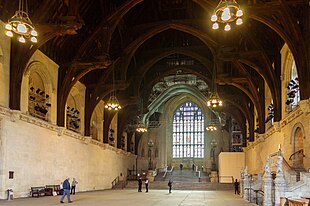
Westminster Hall is a large medieval great hall which is part of the Palace of Westminster in London, England. It was erected in 1097 for William II ("William Rufus"), at which point it was the largest hall in Europe.[1] The building has had various functions over the years, including being used for judicial purposes from the twelfth to the nineteenth centuries. When a joint address is given to the two chambers of the UK Parliament, the House of Commons and House of Lords, the hall is on rare occasions the venue. It is also used for special addresses by Parliament to the Monarch. It was used to host coronation banquets until 1821, and since the twentieth century has been the usual venue for the lyings in state of state and ceremonial funerals.
The fabric of the hall is particularly notable for its hammerbeam roof, a form typical of English Gothic architecture which uses horizontal trusses to span large distances. The roof was commissioned for Richard II in 1393 and built by the royal carpenter, Hugh Herland.[2] It is the largest clearspan medieval roof in England, measuring 20.7 by 73.2 metres (68 by 240 ft).[3][4] At the same time the rest of the hall was remodelled by the master mason Henry Yevele.[5] The renovations include eighty-three unique depictions of Richard's favourite heraldic badge, a resting chained white hart.[6]
- ^ Cescinsky, Herbert; Gribble, Ernest R. (February 1922). "Westminster Hall and Its Roof". The Burlington Magazine for Connoisseurs. 40 (227): 76–84. JSTOR 861585. (subscription required)
- ^ "The hammer-beam roof". UK Parliament. Archived from the original on 30 May 2011. Retrieved 28 May 2011.
- ^ "The Palace of Westminster" (PDF). House of Commons Information Office. May 2009. Archived (PDF) from the original on 25 October 2016. Retrieved 5 August 2010.
- ^ Gerhold (1999), pp. 19–20.
- ^ Jonathan Alexander & Paul Binski (eds), Age of Chivalry, Art in Plantagenet England, 1200–1400, pp. 506–507, Royal Academy/Weidenfeld & Nicolson, London 1987. Only six of the statues, rather damaged, remain, and the dias has been remodelled, but otherwise the hall remains largely as Richard and his master builder Henry Yevele left it.
- ^ Bouell, Charles (1914). Fox Davies, Arthur Charles (ed.). The Handbook to English Heraldry (11th ed.). London: Reeves & Turner. p. 28.